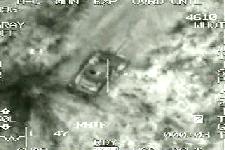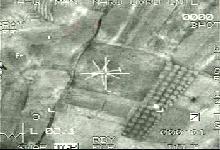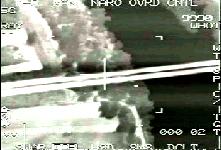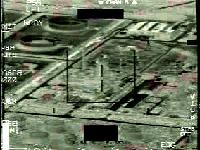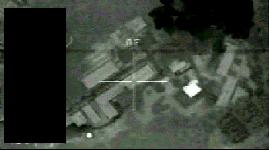Contents:
I.Backround
II.Serb Forces
III.NATO Forces
IV.Serb Losses
V.NATO Losses
VI.Conclusion
VII.Pictures
I.Backround
The conflict over Kosovo dates back many centuries ago. In 1389 the Turks defeated the Serbs and Christian mercenaries allied to the Serbs at the Battle of Kosovo. The Battle of Kosovo would be remembered as the "Field of Blackbirds" because bodies of dead soldiers lay everywhere. The battle ended the Serbian Kingdom and the Ottoman Empire continued to tighten its grip on the Balkans. Serbian Prince Lazar was given 2 choices by the Turks: Fight to the Death or Surrender. He chose to die and with this choice Serbian nationalism began.In 1989 over one million Serbs from all over the world came on a pilgrimage to Kosovo. President Milosevich gave a powerful speech where he said "Never again will the Serbian people be defeated!" Milosevich revived Serb nationalism but he also alarmed minorities in Yugoslavia. Soon after full scale war broke Yugoslavia apart. Sister republics Slovenia, Croatia, Bosnia and Macedonia broke free and became independent. Slovenia and Macedonia were lucky because they got away without a fight. But Croatia and especially Bosnia felt the wrath of Milosevich. The last time the Balkans witnessed such gruesome crimes the Nazis were in power. Concentration camps were built to house Muslims captured by the Serbs. The UN intervened and after the US supplied Bosnia with weapons the tide of the war had turned.
Milosevich began cracking down on Albanians in fear of losing Kosovo. At the time Kosovo's population was 90% Albanian, and enjoyed some autonomy. Milosevich took this away and soon after street protests erupted. The Serb police took tough measures against the Albanians, including beatings and murders. It is at this point that the KLA(Kosovo Liberation Army) was born. The KLA's goals were independence from Yugoslavia and possible reunification with Albania. Serb units had the advantage in weapons, the KLA only had some small weapons. The KLA thus resulted to a guerilla war in Kosovo attacking Serb checkpoints, Police stations, etc. This infuriated Belgrade and sent in the Army to deal with the KLA. As the international community had flashbacks of Bosnia, the Serb Army began a campaign of killing Albanians who they said were part of the KLA. In just a few week an estimated 2,000 Albanians died. The Serbs said that this was a Civil War and not a crackdown on Albanians. Things went out of hand when mass numbers of refugees left Kosovo for Albania and Macedonia. The US took the initiative to try to calm thing down, because this situation could lead to war across the Balkans.
The Kosovo crisis began in early 1998 when large-scale fighting broke out, resulting in the displacement of some 300,000 people. A ceasefire was agreed in October 1998 which enabled refugees to find shelter, averting an impending humanitarian crisis over the winter. A Verification Mission was deployed under the auspices of the Organization for Security and Cooperation in Europe (OSCE). However, violence continued and the situation worsened significantly in January 1999. A peace conference, held in Rambouillet Paris, broke up on 19 March with the refusal of the Yugoslav delegation to accept a peaceful settlement. NATO set out to get Yugoslavia to accept 5 key points, since they refused only airstrikes could make them negotiate.
Five Key Points of Rambouillet:
1. Ensure a verifiable stop to all military action and the immediate ending of violence and repression in Kosovo.
2. Withdrawal from Kosovo of Serbian military, police and paramilitary forces.
3. Agreement to the stationing in Kosovo of an international military presence.
4. Agreement to the unconditional and safe return of all refugees and displaced persons, and unhindered access to them by humanitarian aid organizations.
5. Provide credible assurance of Serbian willingness to work on the basis of the Rambouillet Accords in the establishment of a political framework agreement for Kosovo in conformity with international law and the Charter of the United Nations.
II.Serb Forces

Yugoslav Army Commander: Lt. Col. Gen. Ojdanic
Yugoslav Army Commander in Kosovo: Gen. Nebojsa Pavkovic
Serb Army:
Soldiers: 114,000
Artillery pieces: 1,400
200 M-84 tank
400 T-55 tank
Armored Fighting Vehicles: 1,825
Serb Air Force:
14 MiG-29A/B
60 MiG-21
45 G-4 Super Galeb
20 G-2 Galeb
40 J-22 Orao
Serbian Air Defenses:
40 SA-2
60 SA-3
20 SA-6
?? SA-9
?? SA-11
Numerous SA-7/14/16
AAA pieces: 1,850
There were approximately 40,000 Serb troops in and around Kosovo. These forces were equipped with about 400 tanks and almost 900 APC's. Serb forces around the Kosovo border were divided into deployed forces, garrison forces, and reserve forces. The deployed forces had about 96 tanks, and the garrison forces had around 30 tanks in garrison. There was a concentration of Serb troops along the border between Kosovo and Macedonia, by the former Yugoslav Republic of Macedonia. These forces had been building up for several weeks.
III.NATO Forces


NATO Commander: Gen.Wesley Clark
Country
Aircraft
CV
CG
DD
FF
SSN
Other
Belgium
Canada
Denmark
France
Germany
Greece
Hungary
Italy
Netherlands
Norway
Portugal
Spain
Turkey
United Kingdom
United States
TOTAL
10
18
9
87
15
-
51
39
22
7
3
8
29
38
730
1066
-
-
-
1
-
-
-
-
-
-
-
-
-
-
1
2
-
-
-
-
-
-
-
-
-
-
-
-
-
-
2
2
-
-
-
-
-
1
-
-
-
-
-
-
-
1
2
4
-
-
-
3
1
-
-
1
1
-
-
1
1
2
1
11
-
-
-
1
-
-
-
-
1
-
-
-
-
1
2
5
-
-
-
2
-
-
-
-
1
-
-
-
-
2
5
10
CV= Aircraft Carrier
CG= Cruiser
DD= Destroyer
FF= Frigate
SSN= Submarine
The Kosovo Liberation Army was fighting on its own on the ground against superior Serb forces. The KLA had an estimated 15,000 men all lightly armed. They would bring in supplies from Albania under NATO air cover. Towards the end of the conflict NATO and the KLA worked together on targeting Serb troops with information provided by KLA forces on the ground.
During the first few days NATO's arsenal was much smaller, around 200 aircraft.BGM-109 Tomahawks and other cruise missiles played a key role in the opening days taking out fixed Serb infrastructure. Afterwards aircraft strikes were very conservative because the Serb Defenses posed a serious threat. NATO averaged around 150 sorties a day in the first few weeks, but it steadily increased as time went by. The size of NATO's forces also increased to bring more pressure on Milosevich. NATO leadership also took it easy on Serbia believing minor damage would get Belgrade to realize that it had to stop the killings in Kosovo. Bridges, for example, were only attacked about 1 month into the conflict, whereas in Iraq bridges were taken out during the first days of attack. Another big difference as to why Yugoslavia lasted 79 days is NATO only averaged around 400 sorties compared to 2,500 in Iraq. What I'm getting at is Serbia felt only a small percentage of NATO's wrath, otherwise the conflict would have been over in a few hours.
IV.Serb Losses
Troops Killed: 5,000
Troops Wounded: 10,000
Tanks Lost: 93
APC's Lost: 153
Artillery Pieces Lost: 389
Military Vehicles: 339
Aircraft Lost in Dogfights: 6 Mig-29's & 1 Mi-8
Aircraft Lost on the Ground: about 40-50( 5 Mig-29's, about 20 Mig-21's)
Targeting and hitting Serb troops in Kosovo proved to be a challenge due to bad weather and the terrain allowed the Serbs to hide better. During the final days NATO was given another advantage to hit Serb troops, and that was the KLA. The KLA would attack Serbs in Kosovo until NATO aircraft would come down and drop bombs on the Serbs. In one such incident near the end the KLA brought about 800 Serb troops into the open. A single B-52 Stratofortress bomber carpet bombed the area and all 800 Serb soldiers lost their lives. After the war, NATO investigated the area to see if there were any clues left behind and what they saw only cleared up the fact that around 800 Serb soldiers were caught in the open and obliterated. At the site wreckage abandoned by the Serbs was still present.
For a detailed table on the Kosovo Air War click
here.
V.NATO Losses
Troops Killed: 0
Troops Wounded: 0
Aircraft Lost to SAM's or AAA: 1 F-117
Mechanical Failure Crashes: 4(F-16, AV-8, and 2 Apaches)
For the first time in history a war without casualties. According to Serb sources NATO lost 48 aircraft, 16 helicopters and about 300 soldiers operating on secret missions inside Yugoslavia. Other sites talk about NATO losing as many as 350 aircraft and 500 soldiers. Although the number of sites speaking about hundreds of NATO aircraft lost is high, none can provide any proof other than pictures of 1 F-117 Nighthawk and 1 F-16 Falcon(the F-16 crash land in Yugoslavia after a mechanical failure).The US has absolutely no reason to lie about losses in Kosovo. Follow me for a second: After the US F-15 Eagle performed an excellent tour of duty in Kosovo, downing 6 Mig-29 Fulcrums, the F-22 Raptor was nearly canceled. The reason was that the F-15 has no challengers at this time so why waste money on the F-22. Now, if the F-15 would have taken some losses, the F-22 would have been given more money to become operational.
VI.Conclusion
The Kosovo War proved once again how dominant US Air Power has become. Although the war was not 100% perfect, there were minor accidents, it is as close to perfection as modern warfare will ever get to. This was the first time NATO worked together on such a big scale. Although only a few NATO members participated militarily, all NATO members helped out in some way. New members like Poland, Hungary and the Czech Republic also contributed to the victory. It also paved the way for Bulgaria, Romania, Albania to enter into NATO.
When the Kosovo War began plans called for air power to do the job. Critics from all over said that it could not be achieved due to the terrain and weather of the Balkans. This was proved wrong as NATO achieved all it's goals in just 79 days. This was the first time in history where the Air Force was able to defeat a country by itself, and most amazingly no combat casualties. The Serbs did achieve a "lucky shot" downing 1 F-117 Stealth attack aircraft, but otherwise this was yet another case of US weapon superiority over Russian weapons. Only after the war documents revealed that the Russians had sent SA-10's(S-300's)to Serbia. The SA-10 is the finest SAM in the Russian military, but one system was knocked out by an F-16.
Milosevich finally came to his senses and saw that his country was no match for NATO and gave in to all demands. As of now it appears that Kosovo will be independent and might unite with Albania. Not just that but Montenegro is on the verge of declaring independence as well. NATO statistics show that a total of 38,004 sorties were flown between 24 March and 10 June, an average sortie-generation rate of 494 missions per day. Of the total, 14,006 were strike and suppression of enemy air defences (SEAD) missions (10,808 of which were dedicated strike sorties). In the early days of the campaign, however, the sortie rate over Yugoslavia was more like 150 missions per day. Two new aircraft the B-1 Lancer and B-2 Spirit saw their first action in Kosovo. The B-2 got highest remarks after the war silencing all critics that complained about its cost.
VII.Pictures
Below are some pictures from the war in Kosovo. Click each picture for a greater image.
Map of the
Balkans
Serb Mobile
Weapons
Serbs Taking
Damaged
Armor Home
Cleaning the
Battlefield
Serb
Decoys
Serb Tank
Serb Tank
2
Serb Tank
3
Campaign
Wrap-Up
Table with Serb
Losses
Downed Mig-29 in Bosnia
Downed Mig-29 in Vojvodina
Second Downed Mig-29 in Bosnia
MPEG of a Serb Tank being Destroyed
MPEG of a Serb helicopter being destroyed
MPEG Mig-29 destroyed on the ground
MPEG Destroyed Bridge
MPEG Belgrade Serbian Ministry of Internal Affairs
MPEG Novi Sad Petroleum Refinery
MPEG Army Facility in Belgrade
Serbs removing a destroyed M-84 tank
Blown off M-84 turret
Another destroyed M-84, this is the best Serb tank
Destroyed T-55 tank
Destroyed T-55 tanks
Destroyed troop carrier & T-55 tank
Destroyed M-80 Armored Personnel Carrier
Another destroyed M-80 APC
Yet another destroyed M-80 APC
Destroyed M-60 APC
Another destroyed M-60 APC
Serb armored vehicle victim of deadly NATO accuracy
Yet another "victim"
Destroyed Anti-Aircraft Artillery
Destroyed Serb armor, found and gathered from the US sector
Disabled Serb artillery left behind by Serb troops, captured in US sector
More captured Serb artillery
Destroyed Serb artillery
Serb armor after receiving a "makeover" courtesy of deadly NATO accuracy
Another Serb junkyard in Kosovo

I.Backround |
1. Ensure a verifiable stop to all military action and the immediate ending of violence and repression in Kosovo.
2. Withdrawal from Kosovo of Serbian military, police and paramilitary forces.
3. Agreement to the stationing in Kosovo of an international military presence.
4. Agreement to the unconditional and safe return of all refugees and displaced persons, and unhindered access to them by humanitarian aid organizations.
5. Provide credible assurance of Serbian willingness to work on the basis of the Rambouillet Accords in the establishment of a political framework agreement for Kosovo in conformity with international law and the Charter of the United Nations.
II.Serb Forces |

Yugoslav Army Commander: Lt. Col. Gen. Ojdanic
Yugoslav Army Commander in Kosovo: Gen. Nebojsa Pavkovic
Serb Army:
Soldiers: 114,000
Serb Air Force:
14 MiG-29A/B
Serbian Air Defenses:
40 SA-2
There were approximately 40,000 Serb troops in and around Kosovo. These forces were equipped with about 400 tanks and almost 900 APC's. Serb forces around the Kosovo border were divided into deployed forces, garrison forces, and reserve forces. The deployed forces had about 96 tanks, and the garrison forces had around 30 tanks in garrison. There was a concentration of Serb troops along the border between Kosovo and Macedonia, by the former Yugoslav Republic of Macedonia. These forces had been building up for several weeks.
Artillery pieces: 1,400
200 M-84 tank
400 T-55 tank
Armored Fighting Vehicles: 1,825
60 MiG-21
45 G-4 Super Galeb
20 G-2 Galeb
40 J-22 Orao
60 SA-3
20 SA-6
?? SA-9
?? SA-11
Numerous SA-7/14/16
AAA pieces: 1,850
III.NATO Forces |


NATO Commander: Gen.Wesley Clark
|
Country
|
Aircraft
|
CV
|
CG
|
DD
|
FF
|
SSN
|
Other
|
|
Belgium Canada Denmark France Germany Greece Hungary Italy Netherlands Norway Portugal Spain Turkey United Kingdom United States TOTAL |
10 |
- |
- |
- |
- |
- |
- |
CG= Cruiser
DD= Destroyer
FF= Frigate
SSN= Submarine
The Kosovo Liberation Army was fighting on its own on the ground against superior Serb forces. The KLA had an estimated 15,000 men all lightly armed. They would bring in supplies from Albania under NATO air cover. Towards the end of the conflict NATO and the KLA worked together on targeting Serb troops with information provided by KLA forces on the ground.
During the first few days NATO's arsenal was much smaller, around 200 aircraft.BGM-109 Tomahawks and other cruise missiles played a key role in the opening days taking out fixed Serb infrastructure. Afterwards aircraft strikes were very conservative because the Serb Defenses posed a serious threat. NATO averaged around 150 sorties a day in the first few weeks, but it steadily increased as time went by. The size of NATO's forces also increased to bring more pressure on Milosevich. NATO leadership also took it easy on Serbia believing minor damage would get Belgrade to realize that it had to stop the killings in Kosovo. Bridges, for example, were only attacked about 1 month into the conflict, whereas in Iraq bridges were taken out during the first days of attack. Another big difference as to why Yugoslavia lasted 79 days is NATO only averaged around 400 sorties compared to 2,500 in Iraq. What I'm getting at is Serbia felt only a small percentage of NATO's wrath, otherwise the conflict would have been over in a few hours.
IV.Serb Losses |
Troops Killed: 5,000
Targeting and hitting Serb troops in Kosovo proved to be a challenge due to bad weather and the terrain allowed the Serbs to hide better. During the final days NATO was given another advantage to hit Serb troops, and that was the KLA. The KLA would attack Serbs in Kosovo until NATO aircraft would come down and drop bombs on the Serbs. In one such incident near the end the KLA brought about 800 Serb troops into the open. A single B-52 Stratofortress bomber carpet bombed the area and all 800 Serb soldiers lost their lives. After the war, NATO investigated the area to see if there were any clues left behind and what they saw only cleared up the fact that around 800 Serb soldiers were caught in the open and obliterated. At the site wreckage abandoned by the Serbs was still present.
For a detailed table on the Kosovo Air War click
here.
Troops Wounded: 10,000
Tanks Lost: 93
APC's Lost: 153
Artillery Pieces Lost: 389
Military Vehicles: 339
Aircraft Lost in Dogfights: 6 Mig-29's & 1 Mi-8
Aircraft Lost on the Ground: about 40-50( 5 Mig-29's, about 20 Mig-21's)
V.NATO Losses |
Troops Killed: 0
Troops Wounded: 0
Aircraft Lost to SAM's or AAA: 1 F-117
Mechanical Failure Crashes: 4(F-16, AV-8, and 2 Apaches)
For the first time in history a war without casualties. According to Serb sources NATO lost 48 aircraft, 16 helicopters and about 300 soldiers operating on secret missions inside Yugoslavia. Other sites talk about NATO losing as many as 350 aircraft and 500 soldiers. Although the number of sites speaking about hundreds of NATO aircraft lost is high, none can provide any proof other than pictures of 1 F-117 Nighthawk and 1 F-16 Falcon(the F-16 crash land in Yugoslavia after a mechanical failure).The US has absolutely no reason to lie about losses in Kosovo. Follow me for a second: After the US F-15 Eagle performed an excellent tour of duty in Kosovo, downing 6 Mig-29 Fulcrums, the F-22 Raptor was nearly canceled. The reason was that the F-15 has no challengers at this time so why waste money on the F-22. Now, if the F-15 would have taken some losses, the F-22 would have been given more money to become operational.
VI.Conclusion |
The Kosovo War proved once again how dominant US Air Power has become. Although the war was not 100% perfect, there were minor accidents, it is as close to perfection as modern warfare will ever get to. This was the first time NATO worked together on such a big scale. Although only a few NATO members participated militarily, all NATO members helped out in some way. New members like Poland, Hungary and the Czech Republic also contributed to the victory. It also paved the way for Bulgaria, Romania, Albania to enter into NATO.
When the Kosovo War began plans called for air power to do the job. Critics from all over said that it could not be achieved due to the terrain and weather of the Balkans. This was proved wrong as NATO achieved all it's goals in just 79 days. This was the first time in history where the Air Force was able to defeat a country by itself, and most amazingly no combat casualties. The Serbs did achieve a "lucky shot" downing 1 F-117 Stealth attack aircraft, but otherwise this was yet another case of US weapon superiority over Russian weapons. Only after the war documents revealed that the Russians had sent SA-10's(S-300's)to Serbia. The SA-10 is the finest SAM in the Russian military, but one system was knocked out by an F-16.
Milosevich finally came to his senses and saw that his country was no match for NATO and gave in to all demands. As of now it appears that Kosovo will be independent and might unite with Albania. Not just that but Montenegro is on the verge of declaring independence as well. NATO statistics show that a total of 38,004 sorties were flown between 24 March and 10 June, an average sortie-generation rate of 494 missions per day. Of the total, 14,006 were strike and suppression of enemy air defences (SEAD) missions (10,808 of which were dedicated strike sorties). In the early days of the campaign, however, the sortie rate over Yugoslavia was more like 150 missions per day. Two new aircraft the B-1 Lancer and B-2 Spirit saw their first action in Kosovo. The B-2 got highest remarks after the war silencing all critics that complained about its cost.
VII.Pictures |
|
Map of the
Balkans
|
Serb Mobile
Weapons
|
Serbs Taking
Damaged
Armor Home
|
Cleaning the
Battlefield
|
Serb
Decoys
|
|
Serb Tank
|
Serb Tank
2
|
Serb Tank
3
|
Campaign
Wrap-Up
|
Table with Serb
Losses
|
|
Downed Mig-29 in Bosnia
|
Downed Mig-29 in Vojvodina
|
Second Downed Mig-29 in Bosnia
|
MPEG of a Serb Tank being Destroyed
|
MPEG of a Serb helicopter being destroyed
|
|
MPEG Mig-29 destroyed on the ground
|
MPEG Destroyed Bridge
|
MPEG Belgrade Serbian Ministry of Internal Affairs
|
MPEG Novi Sad Petroleum Refinery
|
MPEG Army Facility in Belgrade
|
|
Serbs removing a destroyed M-84 tank
|
Blown off M-84 turret
|
Another destroyed M-84, this is the best Serb tank
|
Destroyed T-55 tank
|
Destroyed T-55 tanks
|
|
Destroyed troop carrier & T-55 tank
|
Destroyed M-80 Armored Personnel Carrier
|
Another destroyed M-80 APC
|
Yet another destroyed M-80 APC
|
Destroyed M-60 APC
|
|
Another destroyed M-60 APC
|
Serb armored vehicle victim of deadly NATO accuracy
|
Yet another "victim"
|
Destroyed Anti-Aircraft Artillery
|
Destroyed Serb armor, found and gathered from the US sector
|
|
Disabled Serb artillery left behind by Serb troops, captured in US sector
|
More captured Serb artillery
|
Destroyed Serb artillery
|
Serb armor after receiving a "makeover" courtesy of deadly NATO accuracy
|
Another Serb junkyard in Kosovo
|














